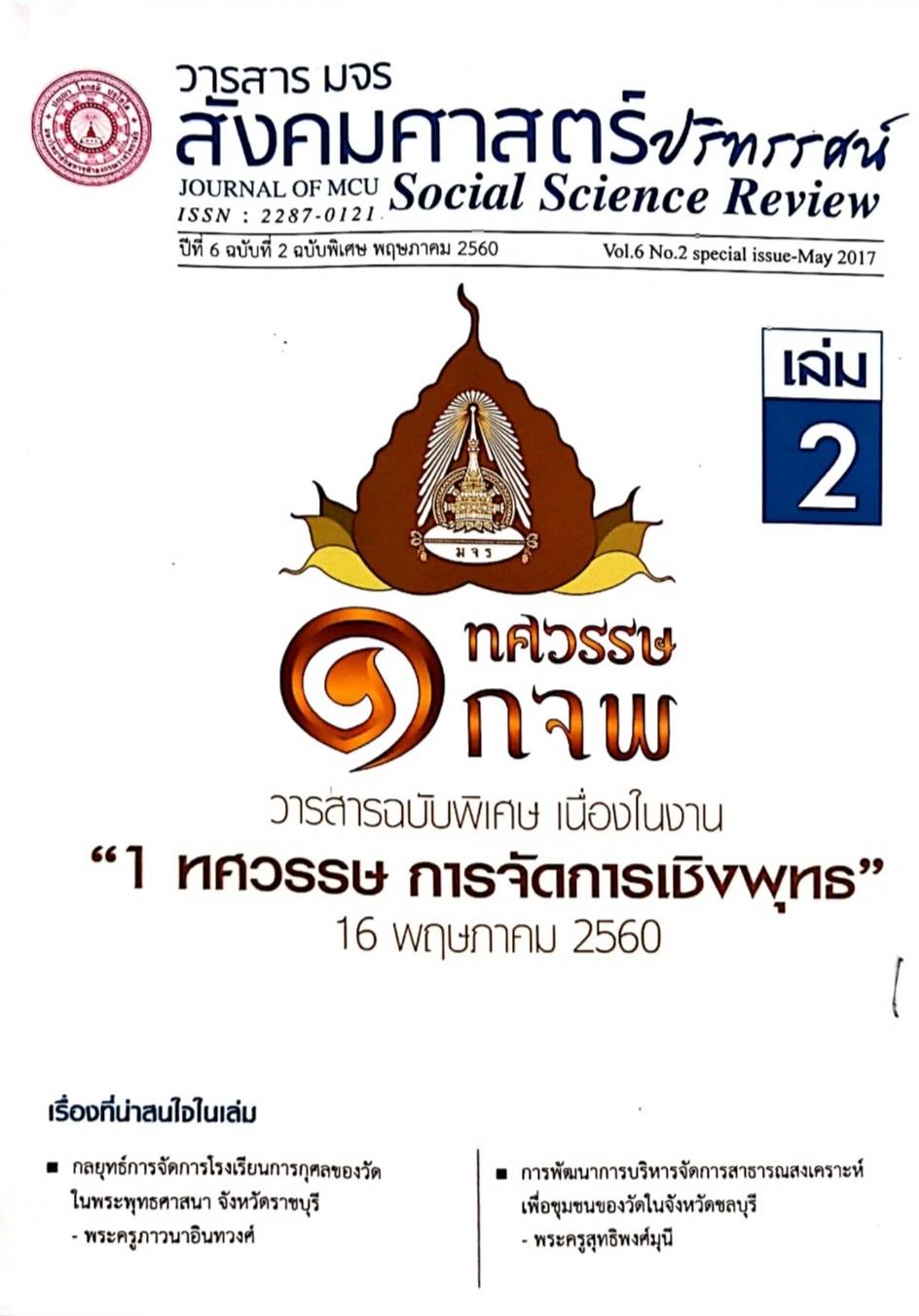MANAGEMENT OF SANGHA ORGANIZATION FOR BUDDHISM STABILITY OF THAILAND
Keywords:
Management Of Sangha Organization, Stability, Buddhism Of ThailandAbstract
This Dissertation aimed (1) to study the state of monastic organization management in Current, (2) to study the composition of monastic organization management, (3) to propose elements of monastic organization management for the stability of Buddhism in Thailand. This study was conducted based on the Tipitaka, Buddhist holy scripture, other related documents, texts, electronic media, and books. Data were taken from in-depth interviews of 25 informants, and then content analysis was performed in accordance with the facts derived from the
1. The research results showed that during the time of Lord Buddha, the Sangha was ruled and managed by the Dhamma democratic principles. The emergence and existence of the Sangha clearly reflected its close relationship with the social context at that time. In fact, the emergence and existence of any organization must be based on the social environment in which that organization is existent. The Sangha organizations should therefore create favorable conditions for the education and development of their members of fraternal organizations. The Buddhist methods of management during the Buddha's life time were, namely,
(1) the establishment and organization of the Sangha or clergy during the Buddha's life time, (2) the division of labor during the Buddha's life time, (3) the delegation of duty and responsibility during the Buddha's life time. Therefore, the organization of Buddhist Sangha at that time was specific and appropriate to the geographic nature and Indian society in those days which could be seen from the stability and prosperity of Buddhism prevalent in Indian society at that time. interview, observations and the focus group of 14 informants.
2. As for the problems and barriers of Buddhist organization management in Thailand, seven important issues had been focused in this research: (1) the system and the model of management, (2) the leadership in management, (3) the personnel management, (4) budgetary management, (5) technology and tools for management, (6) environmental antiques / Buddhist arts / buildings / natural landscape, and (7) the community relationship. In any approach to solving these seven problems in the management of Buddhist organizations, the Sangha should realize that monasteries play the fundamental role in the persistence and continuity of Buddhism. The Sangha at all levels should be responsible for the overall management of all monasteries and Buddhist organizations more than before.
3. Strategic corporate management in order to promote the stability of Buddhism in Thailand should follow the principles of 5M management model with the goal to strive for success. The Sangha executives should therefore develop their personnel to enhance the administration of monasteries and Sangha clergy in these matters, namely (1) the administration, (2) the religious studies, (3) the propagation, (4) the educational support, (5) the public service, and (6) the public support. The 5M model is summarized as follows: (1) M1: (man) / staff /Sangha, (2) M2: (money) money / budget for management of Sangha,(3) M3: (materials) materials, equipment for management of Sangha, (4) M4: (management) management of monasteries and Buddhist organization, (5) M5: (moral) moral integrity and applications. Based on the analysis of data for the current study, 5M model of management is considered effective and appropriate for the management of Buddhist organizations to ensure the stability and continuity of Buddhism and the Buddhist organizations in Thailand
References
พนิดา คล้อสวัสดิ์. (2551). “ปัจจัยเอื้อและแนวปฏิบัติที่เหมาะสมสำหรับการดำเนินการตามแผนยุทธศาสตร์ส่งเสริมการมีส่วนร่วมของภาคเอกชนในการจัดการศึกษาขั้นพื้นฐาน”.วิทยานิพนธ์ปริญญาปรัชญาดุษฎีบัณฑิต. บัณฑิตวิทยาลัย : มหาวิทยาลัยศิลปากร.
พระครูนิวิฐศีลขันธ์ (ณรงค์ ฐิตวฑฺฒโน). (2557). “รูปแบบการพัฒนาทุนมนุษย์ตามหลักพุทธธรรมในองค์กรปกครองส่วนท้องถิ่น”. วิทยานิพนธ์ปริญญาพุทธศาสตรดุษฎีบัณฑิต. บัณฑิตวิทยาลัย : มหาวิทยาลัยมหาจุฬาลงกรณราชวิทยาลัย.
พระครูอุทัยกิจจารักษ์ (สุรางค์ สุจิณฺโณ).(2557).“รูปแบบการบริหารจัดการเผยแผ่พระพุทธศาสนาขององค์กรปกครองคณะสงฆ์ ภาค 2”. วิทยานิพนธ์ปริญญาพุทธศาสตรดุษฎีบัณฑิต.บัณฑิตวิทยาลัย : มหาวิทยาลัยมหาจุฬาลงกรณราชวิทยาลัย.
พระธรรมปิฎก (ป.อ. ปยุตฺโต). (2542). กรณีธรรมกาย. กรุงเทพฯ : โรงพิมพ์มหาจุฬาลงกรณราชวิทยาลัย.
พระธรรมปิฎก (ป.อ. ปยุตฺโต). (2543). นิติศาสตร์แนวพุทธ. พิมพ์ครั้งที่ 4. กรุงเทพฯ : สำนักพิมพ์มูลนิธิพุทธธรรม,
พระมหาธฤติ วิโรจโน. (2557). “รูปแบบการพัฒนาพระสังฆาธิการเพื่อประสิทธิภาพการบริหารกิจการคณะสงฆ์”. วิทยานิพนธ์ปริญญาพุทธศาสตรดุษฎีบัณฑิต. บัณฑิตวิทยาลัย :มหาวิทยาลัยมหาจุฬาลงกรณราชวิทยาลัย.
พระมหาประยุทธ์ ปยุตฺโต. (2513). “บทบาทของพระสงฆ์ในสังคมไทยปัจจุบัน”. ในบันทึกการสัมมนา เรื่องพุทธศาสนาในสังคมไทยปัจจุบัน. พระนคร : ห้างหุ้นส่วนจากัด ศิวพร.
พิรัชย์ ศรีราม. (2556). “ยุทธศาสตร์การพัฒนาธรรมาภิบาลขององค์กรปกครองส่วนท้องถิ่นด้วยหลักพุทธธรรมในเขตจังหวัดภาคกลางตอนบน”. วิทยานิพนธ์ปริญญาพุทธศาสตรดุษฎีบัณฑิต. บัณฑิตวิทยาลัย : มหาวิทยาลัยมหาจุฬาลงกรณราชวิทยาลัย.
สุขุมาลย์ ประสมศักดิ์. (2556). “กลยุทธ์การมีส่วนร่วมของประชาชนในการจัดการสิ่งแวดล้อมตามหลักพุทธธรรมขององค์การบริหารส่วนจังหวัดในกลุ่มจังหวัดภาคกลางตอนบน”.วิทยานิพนธ์ปริญญาพุทธศาสตรดุษฎีบัญฑิต. บัณฑิตวิทยาลัย : มหาวิทยาลัยมหาจุฬาลงกรณราชวิทยาลัย.
อภิษฎาข์ ศรีเครือดง. (2556). “รูปแบบการพัฒนาภาวะผู้นำที่พึงประสงค์ตามแนวพุทธของผู้บริหารสตรีในมหาวิทยาลัยของรัฐ”. วิทยานิพนธ์ปริญญาพุทธศาสตรดุษฎีบัณฑิต.บัณฑิตวิทยาลัย : มหาวิทยาลัยมหาจุฬาลงกรณราชวิทยาลัย.
Downloads
Published
How to Cite
Issue
Section
License
Copyright (c) 2020 Journal of MCU Social Science Review

This work is licensed under a Creative Commons Attribution-NonCommercial-NoDerivatives 4.0 International License.
In order to conform the copyright law, all article authors must sign the consignment agreement to transfer the copyright to the Journal including the finally revised original articles. Besides, the article authors must declare that the articles will be printed in only the Journal of MCU Journal of Social Sciences. If there are pictures, tables or contents that were printed before, the article authors must receive permission from the authors in writing and show the evidence to the editor before the article is printed. If it does not conform to the set criteria, the editor will remove the article from the Journal without any exceptions.





